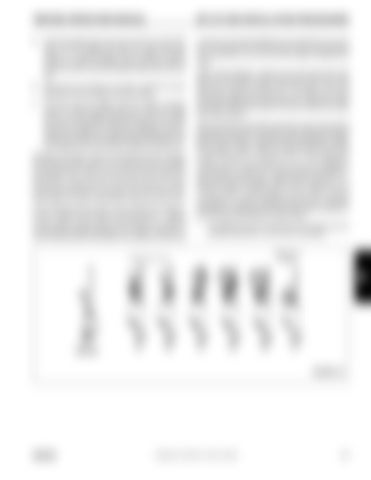TMS700E OPERATORS MANUAL
SET-UP AND INSTALLATION PROCEDURES
5.
a minimum of 6 rope diameters but not less that 15.2 cm (6 inch) for standard 6 to 8 strand ropes and 20 rope diameters but not less than 15.2 cm (6 inch) for rotation resistant wire ropes.
Insert the wedge into the loop and pull the live end of the rope until the wedge and rope are snug inside the socket. It is recommended that the wedge be seated inside the socket to properly secure the wire rope by using the crane’s hoist to first apply a light load to the live line.
6.
After final pin connections are made, increase the loads gradually until the wedge is properly seated.
7.
The wire rope and wedge must be properly secured inside the socket before placing the crane into lifting service. It is the wedge that secures the wire rope inside the socket whereas the dead-end treatment is used to restrain the wedge from becoming dislodged from the socket should the rope suddenly become unloaded from the headache ball or hook block striking the ground, etc.
Sketches A through F (Figure 4-6) illustrate various methods for treating the dead-ends of wire ropes which exit a wedge socket assembly. While use of the loop-back method is acceptable, care must be exercised to avoid the loop b ec o m i n g e n ta n g l e d w i t h t r e e br a nc h e s a nd o t he r components during crane transport and with the anti-two block system and other components during use of the crane. Of the methods shown below, Grove prefers that method A or B or F (Figure 4-6) be used on Grove cranes, i.e., clipping a short piece of wire rope to the dead-end or using a commercially available specialty clip or wedge. Typically, it is recommended that the tail length of the dead-end should be
When using method A, place a wire rope clip around the dead end by clamping a short extra piece of rope to the rope dead end. DO NOT CLAMP THE LIVE END. The U-bolt should bear against the dead end. The saddle of the clip should bear against the short extra piece. Torque the U-bolts according to the figures listed in the chart titled Wire Rope Clip Torque Values. Other sources for information with which crane users should be familiar and follow is provided by the American Society of Mechanical Engineers, American National Standard, ASME B30.5, latest revised. ASME (formerly ANSI) B30.5 applies to cableways, cranes, derricks, hoists, hooks, jacks, and s ling s. I t stat es , in s ec tio n 5 -1 .7 .3, “ (c) Swag ge d, compressed, or wedge socket fittings shall be applied as recommended by the rope, crane or fitting manufacture.” Wire ropes are addressed in ASME B30.5, section 5-1.7.2, ROPES, It states, in pertinent part, “(a) The ropes shall be of a c onst ruction rec ommende d by the ro pe or crane manufacturer, or person qualified for that service.” Additional information is published by the Wire Rope Technical Board in the Wire Rope Users Manual, latest revised. •
The tightening torque values shown are based upon the threads being clean, dry, and free of lubrication.
SPECIALITY WEDGE
SPECIALITY CLIP
4
WRONG
A
B
C
D
E
F
FIGURE 4-6
GROVE
Published 10-05-2010, CTRL # 102-06
4-7


